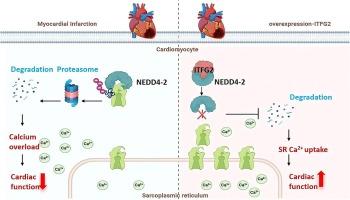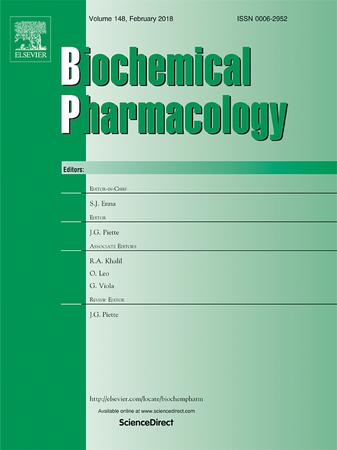ITFG2 作为一种 NEDD4-2 抑制剂:保护钙稳态以防止心肌缺血损伤
IF 5.3
2区 医学
Q1 PHARMACOLOGY & PHARMACY
引用次数: 0
摘要
本研究旨在探讨在心脏组织中高表达的 ITFG2 蛋白在心肌缺血损伤中的作用及其与 NEDD4-2 的潜在相互作用。通过左前降支动脉结扎诱导小鼠体内心肌梗死(MI)模型,并使用腺相关病毒 AAV9 载体调节 ITFG2 的表达。用超声心动图评估心脏功能,培养小鼠原代心肌细胞并使其处于缺氧状态。研究发现,在心肌梗死后和缺氧处理的新生儿心肌细胞中,ITFG2的表达明显减少。过表达 ITFG2 可改善心脏收缩能力,减少细胞凋亡,并通过抑制 NEDD4-2 介导的 SERCA2a 泛素化稳定钙离子水平。相反,敲除 ITFG2 会加重钙超载和心脏功能障碍。从机理上讲,ITFG2 与 NEDD4-2 结合,减少了 NEDD4-2 与 SERCA2a 的相互作用,阻止了 SERCA2a 的降解。这些研究结果表明,ITFG2 是 NEDD4-2 的关键抑制剂,能在缺血条件下保护 SERCA2a 的功能并维持心肌细胞的钙稳态。因此,ITFG2 可能是预防心肌缺血损伤和改善心肌梗死患者预后的潜在治疗靶点。本文章由计算机程序翻译,如有差异,请以英文原文为准。

ITFG2 as a NEDD4-2 inhibitor: Preserving calcium homeostasis to prevent myocardial ischemic injury
This study aimed to investigate the role of ITFG2, a protein highly expressed in cardiac tissues, in myocardial ischemic injury and its potential interactions with NEDD4-2. An in vivo myocardial infarction (MI) model was induced in mice via left anterior descending artery ligation, and ITFG2 expression was modulated using adeno-associated virus AAV9 vectors. Echocardiography was used to assess cardiac function, and primary mouse cardiomyocytes were cultured and subjected to hypoxia. ITFG2 expression was found to be significantly reduced following MI and in hypoxia-treated neonatal cardiomyocytes. Overexpression of ITFG2 improved cardiac contractility, reduced apoptosis, and stabilized calcium levels by inhibiting NEDD4-2-mediated ubiquitination of SERCA2a. Conversely, ITFG2 knockdown exacerbated calcium overload and cardiac dysfunction. Mechanistically, ITFG2 binds to NEDD4-2, decreasing its interaction with SERCA2a and preventing SERCA2a degradation. These findings suggest that ITFG2 acts as a critical inhibitor of NEDD4-2, preserving SERCA2a function and maintaining calcium homeostasis in cardiomyocytes under ischemic conditions. Therefore, ITFG2 may represent a potential therapeutic target for preventing myocardial ischemic injury and improving outcomes in MI patients.
求助全文
通过发布文献求助,成功后即可免费获取论文全文。
去求助
来源期刊

Biochemical pharmacology
医学-药学
CiteScore
10.30
自引率
1.70%
发文量
420
审稿时长
17 days
期刊介绍:
Biochemical Pharmacology publishes original research findings, Commentaries and review articles related to the elucidation of cellular and tissue function(s) at the biochemical and molecular levels, the modification of cellular phenotype(s) by genetic, transcriptional/translational or drug/compound-induced modifications, as well as the pharmacodynamics and pharmacokinetics of xenobiotics and drugs, the latter including both small molecules and biologics.
The journal''s target audience includes scientists engaged in the identification and study of the mechanisms of action of xenobiotics, biologics and drugs and in the drug discovery and development process.
All areas of cellular biology and cellular, tissue/organ and whole animal pharmacology fall within the scope of the journal. Drug classes covered include anti-infectives, anti-inflammatory agents, chemotherapeutics, cardiovascular, endocrinological, immunological, metabolic, neurological and psychiatric drugs, as well as research on drug metabolism and kinetics. While medicinal chemistry is a topic of complimentary interest, manuscripts in this area must contain sufficient biological data to characterize pharmacologically the compounds reported. Submissions describing work focused predominately on chemical synthesis and molecular modeling will not be considered for review.
While particular emphasis is placed on reporting the results of molecular and biochemical studies, research involving the use of tissue and animal models of human pathophysiology and toxicology is of interest to the extent that it helps define drug mechanisms of action, safety and efficacy.
 求助内容:
求助内容: 应助结果提醒方式:
应助结果提醒方式:


